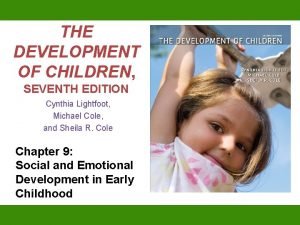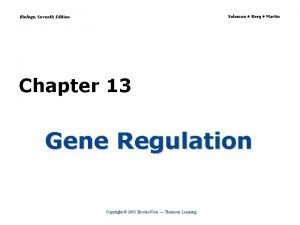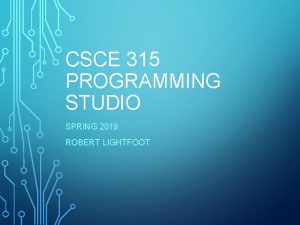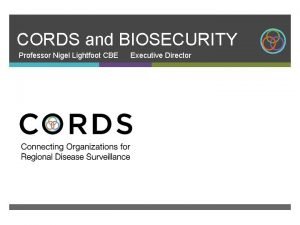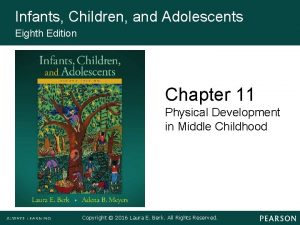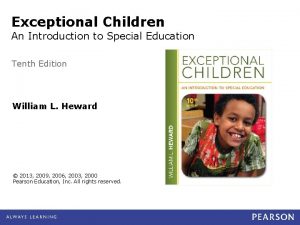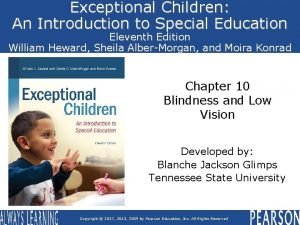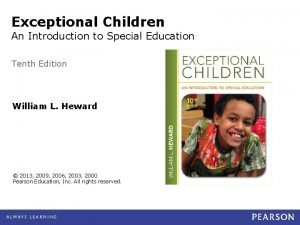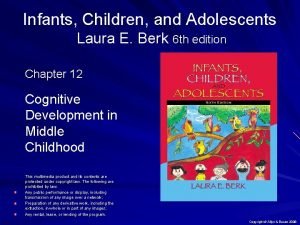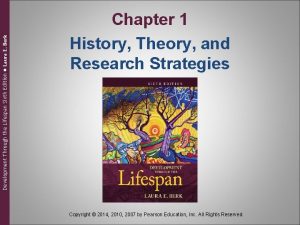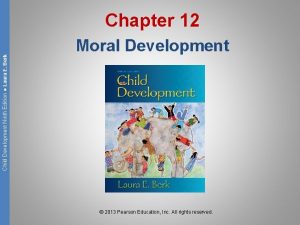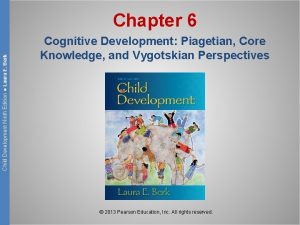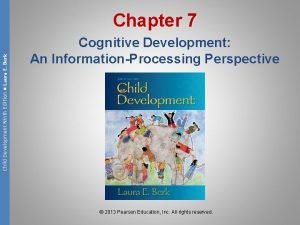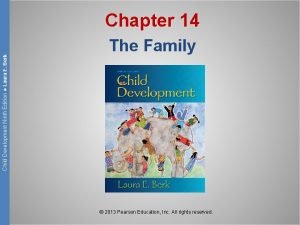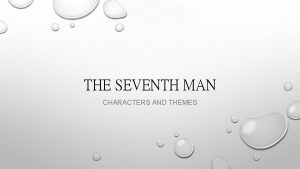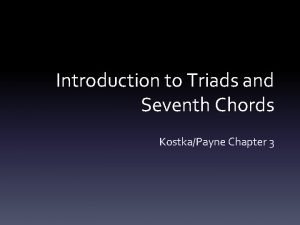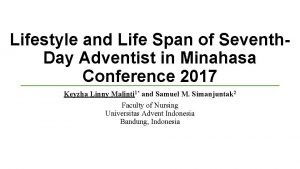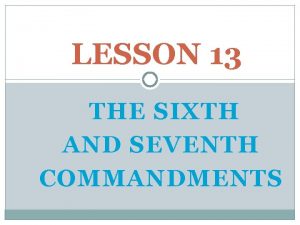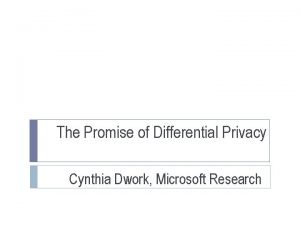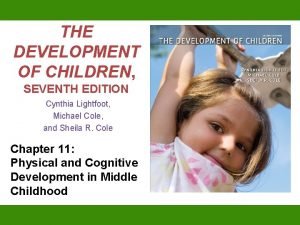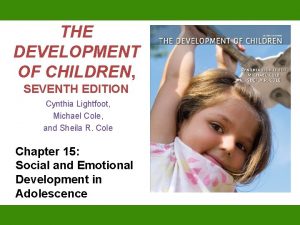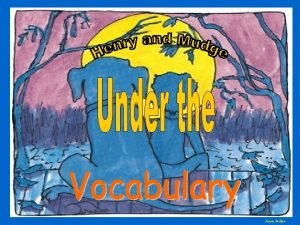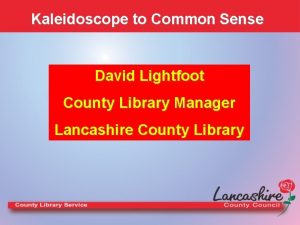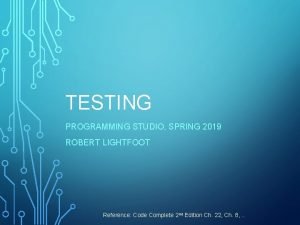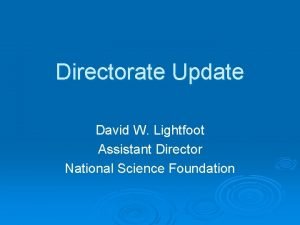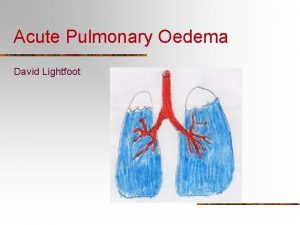THE DEVELOPMENT OF CHILDREN SEVENTH EDITION Cynthia Lightfoot






















































- Slides: 54

THE DEVELOPMENT OF CHILDREN, SEVENTH EDITION Cynthia Lightfoot, Michael Cole, and Sheila R. Cole Chapter 1: The Study of Human Development

Chapter Overview I. Developmental Science II. Children, Society, and Science III. The Central Issues of Developmental Science IV. Theories of Development V. Methods for Studying Development VI. Looking Ahead

The Wild Boy of Aveyron • Jean-Marc Itard’s work is the earliest in the study of child development. • Fundamental questions arose from his work. – To what extent is development determined from birth, and to what extent is it influenced by the environment? – What is the role of early experience in shaping development, and can the effects of negative experience be undone?

I. Developmental Science • Developmental Science: an interdisciplinary field of study that focuses on the changes that children undergo from conception onward. • The field has two goals: 1. The understand the basic biological and cultural processes that account for the complexities of development. 2. To devise ways of safeguarding children’s health and well-being.

The Field of Developmental Science • Developmentalists divide the time between conception and adulthood into five periods: 1. 2. 3. 4. 5. The Prenatal Period (conception to birth) Infancy (birth through 2) Early Childhood (ages 2 1/2 to 6) Middle Childhood (ages 6 through 12) Adolescence (ages 12 through 8)

Domains of Development • The four major areas of development children undergo: 1. 2. 3. 4. Social Emotional Cognitive (intellectual) Physical

Domains of Development • What shapes development? – – Physical Environment Cultural beliefs Family and Peers Neighborhoods and communities – Institutions (e. g. , schools and gov’t)

II. Children, Society, and Science • Historical and cultural context of Developmental Science – Medieval Europe: Children as miniature adults – Protestant Reformation: Harsher child-rearing practices

History of Development Science • Industrial Revolution – Altered family life, education, and work – Contributed to the rise of developmental science

History of Development Science • Darwin’s Theory of Evolution – Origin of Species – New scientific interest in children • Early Twentieth Century – Developmental Science as a recognized field

II. Apply – Connect - Discuss Thumb through some magazines containing images of children – How are these children depicted? Describe their clothing, the activities in which they are engaged, and the objects with them, and the people with whom they are show. – What do these images suggest regarding current conceptions of children and childhood?

III. The Central Issues of Development Science • Research focuses on four fundamental issues: 1. 2. 3. 4. Sources of Development Plasticity Continuity/Discontinuity Individual Difference

Sources of Development • Question about the sources of development: – How do nature and nurture interact to produce development? • Emphasis – Debates the importance of biology and environment

Sources of Development • Nature: – Refers to the individual’s inherited biological predispositions • Nurture: – Refers to the influences on the individual of the social and cultural environment and of the individual’s experience.

Plasticity • Question about plasticity: – To what degree, and under what conditions, is development open to change and intervention? • Greatest Impact – During sensitive periods.

Plasticity • Sensitive Periods: – A time in an organism’s development when a particular experience has an especially profound effect. • • Example of language development Critical Periods: – A period during which specific biological or environmental events are required for normal development to occur. • Example of Imprinting

Continuity/Discontinuity • Question about Continuity/Discontinuity: – To what extent does development consist of the gradual accumulation of small changes, and to what extent does it involve abrupt transformations, or stages? • Examines – Quantitative versus Qualitative Changes

Continuity/Discontinuity • Continuous Development: – Consisting of the gradual accumulation of small changes • • Quantitative Changes Discontinuity: – Involves a series of abrupt, radical transformations • • Qualitative Changes Referred to as Developmental Stages

Continuity/Discontinuity

Individual Differences • Questions about individual differences: – What combination of nature and nurture makes individuals different from one another? – To what extent are individual characteristics stable?

III. Apply – Connect - Discuss • • The central questions of developmental science are also reflected in the way parents and practitioners interpret children’s behavior. Indentify the central question (nature/nurture, continuity/discontinuity, individual differences, plasticity) associated with each of the following phrases:

– – – “Oh, those terrible twos!” “Don’t worry, it’s just a phase. She’ll grow out of it. ” “He’s going on 20” or “He’s 20 going on 2. ” “She’s her own little person. ” “Of course he’s having trouble-his parents work all day and are never home. ” – “He’s been moody since he hit puberty. ” • Now, drawing on your own experience, think of one or more similar phrases for each of the central questions.

IV. Theories of Development • Theory plays an important role in developmental science. • Theory: – A broad conceptual framework to guide the collection and interpretation of facts.

Theoretical Perspectives Development is approached theoretical perspectives: • Four Grand Theories • Four Modern Theories from several

Theoretical Perspectives • Four Grand Theories: 1. 2. 3. 4. Psychodynamic theories Behaviorism Piaget’s Constructivist theory Vygotsky’s sociocultural theory

Psychodynamic Theories • Theories exploring the influence on development and developmental stages of the universal biological drives and life experiences of individuals.

Psychodynamic Theories • Key Psychodynamic Theorists – Sigmund Freud • In which psychosexual stages are associated with the changing focus of the sex drive – Erikson • In which psychosocial stages are associated with tasks or crises shaped by social and cultural factors.

Psychodynamic Theories

Behaviorism • Theories that focus on development as the result of learning, behavioral changes resulting from the individual’s forming associations between behavior and consequences.

Behaviorism • Key Learning Theorists – John B. Watson – Edward Thorndike – B. F. Skinner

Piaget’s Constructivist Theory • Piaget’s theory, in which cognitive development results from children’s active construction of reality based on their experiences with the world.

Piaget’s Constructivist Theory • Concepts: – Children progress through universal stages of cognitive development. – As children strive to master their environments, they change their schemas through adaptation. – A schema is the most basic unit of cognitive functioning.

Piaget’s Constructivist Theory

Vygotsky’s Sociocultural Theory • • Vygotsky’s theory focuses on the role of culture in development and on children learning through finely tuned interactions with others who are more competent. Zone of Proximal Development: – The gap between what children can accomplish independently and what they can accomplish when interacting with others who are more competent.

Four Grand Theories • Insert new Table 1. 4

Influential Modern Theories • Four Modern Theories 1. 2. 3. 4. Evolutionary Theories Social Learning Theories Information-Processing Theories Systems Theories

Evolutionary Theories • • Theories look at how human characteristics contributed to the survival of the species and to how our evolutionary past influences individual development. Concept of Ethology

Social Learning Theory • Theories that focus on the learning of associations between behaviors and their consequences but emphasize learning that occurs through the observation of, and interaction with, others.

Information-Processing Theories • Theories look at how children process, store, organize, retrieve, and manipulate information in increasingly efficient ways. • Analogous with computer processing

System Theories • Theories that envision development in terms of complex wholes made up of parts and that explore how these wholes and their parts are organized and interact over time.

System Theories • Dynamic systems theory: – Focuses on the development of new systems of behavior from the interaction of less complex parts • Ecological systems theory: – Focuses on the organization of the environmental contexts within which children develop.

Uri Bronfenbrenner’s Ecological system

IV. Apply – Connect - Discuss • Parminder is playing intently with wooden blocks. She puts one on top of another, and looks at her mother, who smiles and exclaims, “Oh, aren’t you cleaver? You got it on top! Are you a proud little girl? ” Parminder grasps another block and repeats her performance. She smiles broadly at her mother, who again responds with happy excitement. On the third try Parminder topples her tower, and bursts into tears. “Poor baby! They fell down and now you’re angry. Here, let me help you make another tower”. • This scenario can be explored from several different theoretical perspectives. Considering theories of Erikson, Vygotsky, and Piaget, what would you focus on? How would you interpret the scenario?

V. Methods of Studying Development • Goals of Developmental Research 1. Basic Research: designed to advance scientific knowledge of human development 2. Applied Research: designed to answer practical questions related to improving children’s lives and experiences. 3. Action Research: designed to provide data that can be used in social policy decision making.

Methods of Studying Development • Criteria for Developmental Research – – – Objectivity Reliability Replicability Validity Ethically Sound

Methods of Data Collection • Naturalistic Observation – Involves watching children in the course of their everyday lives and recording what happens • Experiments – Consist of introducing some change in a group’s experience and measuring effects on the group’s members, who are compared to a similar group that did not undergo the experience

Methods of Data Collection • Clinical Interviews – Allows researchers to tailor data collection to each research participant.

Methods of Data Collection

Research Design • Longitudinal design: studies the same children repeatedly over a period of time. • Cross-sectional design: studies different ages at a single time. children of

Research Design • Cohort sequential design: combines the logitudinal and cross-sectional approaches by studying several cohorts over time. • Microgenetic design: studies the same children over a short period, often one of rapid change.

Research Design

V. Apply – Connect - Discuss • Your little brother brought home the following letter from school. • Evaluate the scientific and ethical merits of the study described. Propose an alternative study that will address the issues.

V. Apply – Connect - Discuss Dear Parent or Guardian, In response to the mayor’s proposal to re-route a major highway past our elementary school, we will conduct a study of the relationship between road noise and learning in our students. With the assistance of Dr. Heezrite of Baloney University, your child, JONATHON, has been randomly assigned to the following group: – During a lesson in mathematics, your child will be exposed to unexpected loud noises, similar to truck horn blasts, after which he/she will be given a test covering the content of the lesson. – After a lesson in mathematics, your child will be given a test covering the content of the lesson. Thank you for your cooperation in our effort to provide the best learning environment for our children. Sincerely, THE PRINCIPAL

VI. Looking Ahead • Biocultural Approach – Emphasizes on how biological and cultural processes intertwine • Taking this approach, the book will trace development in the physical, social, emotional, and cognitive domains across the periods of childhood.
 Critical period vs sensitive period
Critical period vs sensitive period Gordon lightfoot ethnicity
Gordon lightfoot ethnicity Human anatomy and physiology seventh edition marieb
Human anatomy and physiology seventh edition marieb Chords rule in dbms
Chords rule in dbms Information management principles
Information management principles Molecular biology of the cell seventh edition
Molecular biology of the cell seventh edition Biology seventh edition
Biology seventh edition Guy lightfoot
Guy lightfoot Guy lightfoot
Guy lightfoot Robert lightfoot tamu
Robert lightfoot tamu Joshua lightfoot
Joshua lightfoot Nigel lightfoot
Nigel lightfoot Gains in perspective taking permit the transition to
Gains in perspective taking permit the transition to Discontinuity of development
Discontinuity of development Exceptional children 10th edition
Exceptional children 10th edition Exceptional children 11th edition
Exceptional children 11th edition Exceptional children 10th edition
Exceptional children 10th edition Infants, children, and adolescents 8th edition
Infants, children, and adolescents 8th edition Infants and children 8th edition
Infants and children 8th edition Mis chapter 6
Mis chapter 6 Report
Report Unit 18 assessing children's development support needs p1
Unit 18 assessing children's development support needs p1 Week by week plans for documenting children's development
Week by week plans for documenting children's development Development through the lifespan 6th edition
Development through the lifespan 6th edition Laura e berk child development 9th edition pdf
Laura e berk child development 9th edition pdf Child development berk 9th edition
Child development berk 9th edition Cognitive theory child development
Cognitive theory child development Laura e berk child development (9th edition pdf)
Laura e berk child development (9th edition pdf) Child development ninth edition
Child development ninth edition Lifespan development third edition
Lifespan development third edition Lifespan development third edition
Lifespan development third edition The devil from seventh grade 1960
The devil from seventh grade 1960 Who are the characters in the seventh man
Who are the characters in the seventh man Thou shalt not steal 7th commandment
Thou shalt not steal 7th commandment Circle of hell
Circle of hell Seventh-day adventist leadership structure
Seventh-day adventist leadership structure Inversion hotline
Inversion hotline Brave seventh grade viking warrior
Brave seventh grade viking warrior Masahiro murakami
Masahiro murakami Article 9 of the creed
Article 9 of the creed Seventh grade by gary soto character traits
Seventh grade by gary soto character traits Seventh normal form
Seventh normal form Hamlet's 7th soliloquy analysis
Hamlet's 7th soliloquy analysis Seventh day baptist
Seventh day baptist The fifth, sixth, seventh, and eighth amendments protect *
The fifth, sixth, seventh, and eighth amendments protect * 7th day adventist lifestyle
7th day adventist lifestyle 7th commandment worksheet
7th commandment worksheet At the seventh sprint review the stakeholders
At the seventh sprint review the stakeholders Seventh grade by gary soto character traits
Seventh grade by gary soto character traits What is the 7 trumpets
What is the 7 trumpets Curtain sign ear
Curtain sign ear 8 amendment
8 amendment Kids activity in riverside seventh day baptist church
Kids activity in riverside seventh day baptist church Cynthia cooper (accountant)
Cynthia cooper (accountant) Cynthia dwork differential privacy
Cynthia dwork differential privacy

